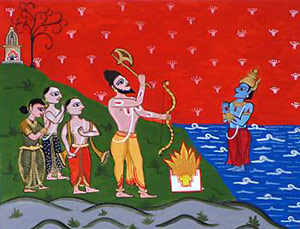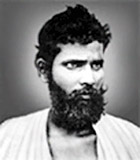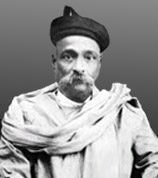Chitpavan Brahmins of Maharashtra, whose origin is obscure, were not heard of before 1700 AD. According to the Sahyadri Khand, the legend goes that Parashurama was so defiled by the slaughter of the Kshatriyas that the Brahmins refused to perform any ceremonies for him. At that time, the bodies of fourteen shipwrecked foreigners happened to be  cast ashore by the sea that washed the foot of the Sahyadri Hills. Parashurama purified their corpses by burning them on a funeral pyre and restored them to life, taught them Brahmin rites and made them perform ceremonies so as to free him from his bloodguilt. As he wished to reward his new priests he prayed to the sea to spare some of its domain and in response it retired as far west as Parasurama`s arrow, shot from the crest of the Sahyadris could go. He, thus, reclaimed a belt of land about 48 kilometers broad and a tract on the banks of the Vashishthi, about sixty-four kilometres north of Ratnagiri, was set apart for these new Brahmins. In memory of the process by which they had been purified, they were given the name of Chitpavans and their settlement that of Chitpolan.
cast ashore by the sea that washed the foot of the Sahyadri Hills. Parashurama purified their corpses by burning them on a funeral pyre and restored them to life, taught them Brahmin rites and made them perform ceremonies so as to free him from his bloodguilt. As he wished to reward his new priests he prayed to the sea to spare some of its domain and in response it retired as far west as Parasurama`s arrow, shot from the crest of the Sahyadris could go. He, thus, reclaimed a belt of land about 48 kilometers broad and a tract on the banks of the Vashishthi, about sixty-four kilometres north of Ratnagiri, was set apart for these new Brahmins. In memory of the process by which they had been purified, they were given the name of Chitpavans and their settlement that of Chitpolan.
The Chitpavans are a community whose impact outgrew its size. They began to call themselves Konkanastha about 1715 AD when Peshwa Balaji Viswanath rose to eminence in the Maratha kingdom. They are light complexioned with good built and handsome. They often had blue or green eyes and hair that is not dark. Originally from the town of Chitpol in Ratnagiri, they are well placed in government services and had become prominent in the fields of scholarship, the arts, social reform and law by the 19th century. Of their two sect names, Konkanasth and Chitpavan, the first indicates the rocky, unyielding land in the Ratnagiri District of the Konkan. The name, Chitpavan, would seem to have originated in the name `Chitpol`, the Konkan town.
A historian of the Bene Israelis, who settled in the Kolaba District of the Konkan, claims the Chitpavans are fellow Jews who became separated from their shipmates and settled in India. Other accounts have guessed at a homeland anywhere from Iran to just north of Sholapur.
As long as they remained in the Konkan, the Chitpavans were simply an obscure Brahmin community of farmers and priests. The land that they tilled afforded only a poor living. But it should be noted that money was never on their priority list. They were neither the largest nor the purest in the Brahmin hierarchy but their common sense and intelligence made them rise to power.
Balaji Vishwanath Bhat took up service with the Maratha government in the early 1700s. He had a talent for making himself indispensable so much so that within 7 years Shivaji`s grandson, Shadu, had appointed him his peshwa. His son, Bajirao, succeeded him in 1720 and thus began a century of rule by the Chitpavan Peshwas. Lured by these examples of good fortune, the Chitpavans migrated in large numbers to the Deccan, especially to Pune where they quickly rose in stature and influence, claiming economic and other privileges.
 The end of power and glory came in 1818, when the British subjugated the Maratha kingdom. They served the British for some time although unwillingly. Wasudeo Balwant Phadke, one of the more spirited among them, dreamed of restoring the office and power of the Peshwa. In 1879 he left his job of a government clerk and started raiding the countryside. Although he was captured his example inspired others to resist.
The end of power and glory came in 1818, when the British subjugated the Maratha kingdom. They served the British for some time although unwillingly. Wasudeo Balwant Phadke, one of the more spirited among them, dreamed of restoring the office and power of the Peshwa. In 1879 he left his job of a government clerk and started raiding the countryside. Although he was captured his example inspired others to resist.
Among the outstanding social reformers from this community were D.K. Karve, who established a home and school for young widows and set an example by marrying a widow himself. on the other hand M.G. Ranade wrote in favour of widow marriage and of raising the marriage age of consent; and G. K. Gokhale, who established the Servants of the India Society. D.K. Karve was, however, ostracized for breaking the orthodoxy rules and he had to make a visit for purification to Varanasi so as not to be excommunicated.
Among the great nationalists were Bal Gangadhar Tilak and S.M. Paranjpe. Both were jailed several times. Vishnu Shastri Chiplunkar wrote Our Country`s Condition to attack British rule on the one hand and Phule`s non-Brahmin movement on the other.
From the time of Balaji`s rise to power in the Maratha court, the Chitpavans have had a hand in government, a tradition perpetuated by men like Ranade and Gopal Krishna Gokhale. Both urged peaceful reforms in British policy. Ranade and another young Chitpavan intellectual, G.V. Joshi formed the Poona Sarvajanik Sabha in 1870 as a representative body to recommend changes to the government. Moderates like Gokhale and Ranade led the Indian National Congress in its early stages in political reform.
But the other side to the Chitpavans` political activity was terrorism. The Chapekar brothers formed the Society for the Removal of Obstacles to the Hindu Religion; one of the `obstacles` being Rand of the Plague Commission who, on a June night in 1897, was `removed`.
 Other conspiracies were brewed, sometimes among students of the Ferguson College, which had been established by such eminent Chitpavans as Tilak, V.S. Apte and Gokhale. Another pair of young brothers, Vinayak and Ganesh Savarkar, planned ways of overthrowing the British government with their friends. When Ganesh was convicted of writing "inflammatory verse" in 1909, the district magistrate of Nasik was murdered in reprisal. Twenty-seven men were convicted as members of the conspiracy, most of them Chitpavans.
Other conspiracies were brewed, sometimes among students of the Ferguson College, which had been established by such eminent Chitpavans as Tilak, V.S. Apte and Gokhale. Another pair of young brothers, Vinayak and Ganesh Savarkar, planned ways of overthrowing the British government with their friends. When Ganesh was convicted of writing "inflammatory verse" in 1909, the district magistrate of Nasik was murdered in reprisal. Twenty-seven men were convicted as members of the conspiracy, most of them Chitpavans.
Nathuram Godse was probably the last, and certainly the best-known, of the Chitpavan terrorists and the news of his assassination of Gandhi caused anti-Brahmin riots to break out in Maharashtra.
Bal Gangadhar Tilak, a revered public figure, both orthodox and revolutionary, tried to reconcile the opposing elements in the community. He opposed British social legislation insisting that it should come from the people. In an attempt to realise this he drew the masses into meaningful political movements. He revived the Ganapati celebrations and renewed people`s interest in Shivaji, making both these subjects the vehicles of political action.
During the 1930s and 1940s, discontented Maharashtrian Brahmins began to leave the Congress and non-Brahmins took their places. Though they were among the leaders in certain other parties, they found that democracy in India did not do justice to minorities. The Brahmins being only about 2% of the population could not hope to carry much weight politically.
Like those from other communities, many Chitpavans now opt for employment in the professions instead of the government services. Especially popular are engineering and other technical vocations.
Today the young Chitpavan is not much concerned about the community`s reduced political role and the anti-Brahmin sentiment that still lingers. In a society frequently tied up in its traditions and restrictions, the Chitpavans have been adaptable enough to change with the times.




















